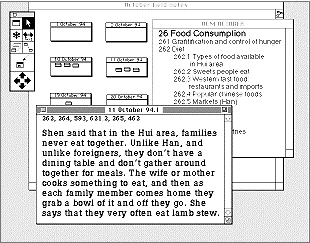Storyspace in China
Maris Boyd Gillette
Although Storyspace receives much attention as a tool for writers, it is useful for a variety of other professions as well. In my studies of a Chinese Muslim (Hui) community in Northwest China (Xian), Storyspace becomes an aid to the creation of ethnographic field notes. By integrating the anthropological index of the Outline of Cultural Materials with Storyspace, I produce an instrument which organizes field notes both chronologically and topically, and aids the creation of reports, articles, and ultimately of a doctoral dissertation.
Storyspace...is better suited to the qualitative, descriptive data produced by ethnographic field work
Storyspace enables me to organize my work both chronologically and topically, in a few easy steps and without painful and time-consuming duplication of data.
Because Storyspace is designed to build complex textual structures, it is better suited to the qualitative, descriptive data produced by ethnographic field work than are other database programs. The visual layout of Storyspace clearly demarcates the structure of each document, facilitating quick access to data.

As I record each day's fieldwork in Storyspace, I parse it into broad topics such as marriage, exchange, food consumption...
I keep a chronological month-by-month record of my field work using Storyspace writing spaces. Each month's research is stored in a separate Storyspace document. Each day is represented by writing space in which I summarize the day's events, the weather, and my personal feelings and condition. Inside the writing space I then add additional writing spaces which provide a topical overview of the day's events. For example, one writing space might contain part of a conversation during which my informant told me about eating practices during Ramadan. The part of our conversation in which she told me about hair styles and veiling for Chinese Muslims would be placed in a separate writing space.
After recording these notes, I assign topic numbers to the notes based on the index numbers in the Outline of Cultural Materials, an index of anthropological topics which provides one way of organizing ethnographic data into analytical categories. For example, marriage is a major topic in social and cultural anthropology and receives the number 58. The category 58 (Marriage) is then broken down into components such as arranging a marriage (584), nuptials (585), and secondary marriages (587). I also create new categories specifically relevant to my work among the Hui, such as marriage introduction bureaus (584.1). As I record each day's fieldwork in Storyspace, I parse it into broad topics such as marriage, exchange, food consumption, etc. Each writing space addresses one central issue like marriage, as well as other topics the informant might touch on, such as clothing (the informant talked about her wedding dress) or exchange (the informant discussed the wedding presents her relatives gave her).
the main advantage of this system comes when I wish to write a report.
In each month's field notes I also make a writing space, titled "OCM", that contains the OCM index. I then link the individual writing spaces to this OCM index, which allows me to access my data topically. For example, when I follow a link from the index, Storyspace will list all writing spaces which address the selected topic. I can then follow the links to review all the data I have collected on this subject, in any order I choose.
For my work, the main advantage of this system comes when I wish to write a report. When I have enough data to provide a fairly complete description of a particular topic or event, I use the Storyspace "gather" feature and the "path builder" to collect all the writing spaces which pertain to that topic. I copy these gathered writing spaces from each month's research and paste them into a new Storyspace document entitled with the name of the topic, e.g. "marriage", "halal", or "Ramadan." (I work with copies of my Storyspace documents when performing these tasks, so that the chronological record of field work remains intact.) After I have collected all my data on the relevant topic, I can read and sort it, discard what is irrelevant, export my data to my word processing program, reorganize it in a logical sequence, fix the prose, and analyze the material. After I have finished these tasks, I have a completed report on a topic, which will become the basis for chapters of my dissertation.